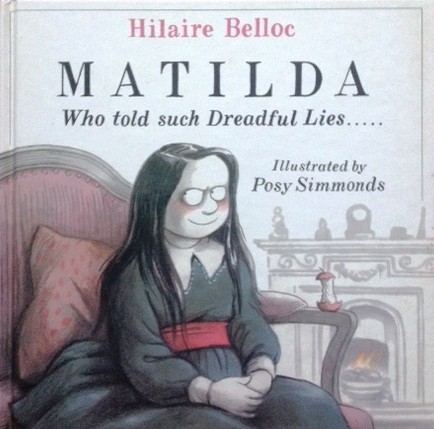Inspiring Young Readers
 posted on 17 Mar 2022
posted on 17 Mar 2022
Matilda, who told such dreadful lies by Hilaire Belloc, illustrated by Posy Simmonds
The cautionary tale has been a staple of children’s literature stretching back to its origins in the 17th century – most fairy tales have their roots in stories that warn the young about the perils life has in store for them. And lots of authors have rather delighted in making these cautionary tales as dark and deadly as possible: just try reading the original Grimm Tales for example which before being sanitised for a more sensitive modern audience were originally often cruel and bloodthirsty.
It probably won’t come as a surprise to discover that the Victorians were very fond of the cautionary tale for children, especially as they lent themselves so well to moral proselytising and Christian evangelising. Much of this output is horribly po-faced and sanctimonious and ripe for a bit of ironic send-up – which duly arrived in the shape of Hilaire Belloc’s ‘Cautionary Tales for Children: Designed for the Admonition of Children between the ages of eight and fourteen years’, published in 1907.
‘Matilda, who told such dreadful lies’ is one of eleven tales told in rhyming couplets contained in this collection from Belloc and it’s this one that has been selected for illustration by the wonderful Posy Simmonds.
The verse itself is waspish and cruelly amusing:
Matilda told such Dreadful Lies,
It made one Gasp and Stretch one’s Eyes;
Her Aunt, who, from her Earliest Youth,
Had kept a Strict Regard for Truth,
Attempted to Believe Matilda:
The effort very nearly killed her,
And would have done so, had not She
Discovered this Infirmity.
For once, towards the Close of Day,
Matilda, growing tired of play,
And finding she was left alone,
Went tiptoe to the Telephone
And summoned the Immediate Aid
Of London’s Noble Fire-Brigade.
Within an hour the Gallant Band
Were pouring in on every hand,
From Putney, Hackney Downs, and Bow
With Courage high and Hearts a-glow
They galloped, roaring through the Town
‘Matilda’s House is Burning Down!’
Inspired by British Cheers and Loud
Proceeding from the Frenzied Crowd,
They ran their ladders through a score
Of windows on the Ball Room Floor;
And took Peculiar Pains to Souse
The Pictures up and down the House,
Until Matilda’s Aunt succeeded
In showing them they were not needed;
And even then she had to pay
To get the Men to go away!
It happened that a few Weeks later
Her Aunt was off to the Theatre
To see that Interesting Play
The Second Mrs Tanqueray.
She had refused to take her Niece
To hear this Entertaining Piece:
A Deprivation Just and Wise
To Punish her for Telling Lies.
That Night a Fire did break out-
You should have heard Matilda Shout!
You should have heard her Scream and Bawl,
And throw the window up and call
To People passing in the Street-
(The rapidly increasing Heat
Encouraging her to obtain
Their confidence)-but all in vain!
For every time She shouted ‘Fire!’
They only answered ‘Little Liar’!
And therefore when her Aunt returned,
Matilda, and the House, were Burned.
Clearly indebted to the tale of the boy who cried wolf, Belloc’s gleeful dispatching of the irritating Matilda might induce a gratified, knowing smile in an adult who is having a moment of fantasy wish-fulfilment that has no real-world consequences but it’s not really the verse that makes this lavish 1991 version so delectable. What this book boasts are some of the most delightful illustrations any reader could wish for from the pens of the incomparable Posy Simmonds.
This Matilda is in every way a modern late 20th century girl who happens to be living in stuffy Edwardian England. The splendidly wicked Matilda relieves her boredom by giving free-rein to her impulsive naughtiness and lying – on this occasion summoning the gallant fire brigade to a non-existent conflagration. Of course, when there is a real fire, no-one wants to be fooled again and poor old Matilda goes up with the building.
As with all great illustrators the drawings are able to capture the complex range of emotions that the story suggests – from the minor irritations of the parlour to the real tragedy of a small girl trapped in a burning building.
Parents and children might have fun discussing whether Matilda’s fate is proportionate to her sins………..
Possibly out of print at the moment, second hand copies can be found on line but you’ll have to pay in excess of £20 for a decent hardback.
Terry Potter
March 2022




